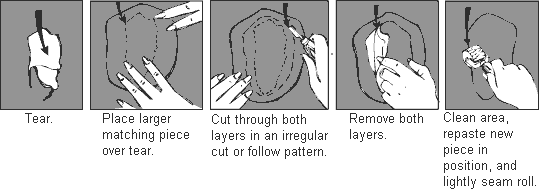Wallpaper / Wallcovering Tips and Information
Why wallpaper... isn't paint cheaper and easier?
Before tackling any home improvement or decorating project, there are recent rulings established to prevent the hazards of lead-based paint. To read more on these wallpaper tips, click here.
A professional wallpaper installation may last 15 to 25 years or more with a look that you simply cannot get from paint. Wallpaper and installation are paid for once. As opposed to multiple purchases of paint and labor to over the same period. Wallpaper is far easier to clean up when compared to paint as well. Generally speaking, you can wipe up any marks or stains from a wallpaper’s acrylic or vinyl surface with a sponge. While the same can be said of modern painted surfaces, many times this leaves a shiny or dull spot where marks or stains used to be on a painted surface. For further information, please refer to our Why Wallpaper Page.
Where do I buy wallpaper?
There are a few ways that you can purchase wallpaper. Interior decorators, home improvement stores, and your local paint or wallpaper stores. Interior decorators are generally the most expensive route, though they may offer the best advice as to what particular wallcoverings best complement your overall decorating scheme. Local paint, wallpaper, and home improvement stores generally save you more money, but you will need to spend time matching your wallpaper needs with your existing home decor. Some of these stores have free in-house consultants for this purpose.
What is a pattern match?
On all wallpaper, except some textures and murals, there is what is called a pattern match or pattern repeat. This is the vertical distance between one point on a pattern design to the identical point vertically. This pattern repeat is an integral part of the design. A random match is one in which the pattern matches no matter how adjoining strips are positioned. Stripes are a good example. A straight-across match is one in which the design elements match on adjoining strips. A drop match is one in which there is a vertical drop between the matching design elements. With straight-across matches, every hung strip is the same as the ceiling line. With drop matches, the number of strips hung before a strip is repeated is dependent on the type of drop match. Patterns with a significant drop match (24 inches or greater) will require additional wallpaper to be ordered.
How do I measure for wallpaper?
Refer to the wallpaper estimation page.
Do I need an interior decorator?
No, as long as you are willing to invest the time to browse through the wallpaper books to find the wallpaper that suits your taste. If you are unsure about what wallpapers will complement your home decor, most home improvement centers and wallpaper stores have associates who will be able to assist you. Home improvement and wallpaper stores generally sell for 10-50% (or more) off of full list price.
Can I hang it myself? What are the wallpaper tips for DIY?
Yes. There are numerous resources available online and at home improvement stores to aid in self-installation. First-time installers should avoid kitchens and bathrooms, as these are more complicated. Certain types of wallpaper should only be hung by professionals and you must match your particular skill level, wallpaper type, and complexity of application to give you a fair indication whether it’s time to call for help.
Can I repair a small tear?
Yes, and if done properly, the repair is practically invisible. As illustrated below, place a larger piece of wallpaper over the tear so that it makes an exact match with the wallpaper on the wall. Use a razor knife (with new blade) to double-cut through both layers around the tear. Remove both layers, clean the exposed wall area and re-paste the new piece into the area. After 15 minutes lightly seam-roll the fitted edge. Note that an irregular, wavy cut following the design in the wallpaper will make your cut less noticeable. If there is a pattern around the damaged area, attempt as much as possible to follow this pattern with your cuts, as this will camouflage the repair as well.
Can I hang wallpaper over old paneling, brick,
textured walls, etc.?
Absolutely. Start with good preparation by removing all nails or other protruding objects. For textured surfaces, "knock down" any high points. For paneling, now is the time to ensure that the paneling is secure. Do this by adding additional nails if needed. For slick surfaces/paneling, wash with TSP (TriSodium Phosphate) or equivalent grease cutting cleaner.
Now, you can hang bridging material. This is thick, blank wallpaper designed for irregular surfaces. Once hung, this will "bridge" the grooves in paneling or other unusual surface allowing for the ultimate application of wallpaper or paint.
Alternate/additional advice: The application of joint compound to the grooves of paneling is an additional precaution when using bridging material. Some wallpaper installers use the "joint compound, then primer" technique instead of bridging material.
For ceramic or other tile, sand the surface with 200-400 grit sandpaper followed by rinsing with TSP. Apply a prep coat and then hang your bridging material. Examples of prep coats include Roman’s R-35, Zinsser’s Z-54, California Paint’s Prep ‘n Size, Golden Harvest’s BITE, Muralo’s Adhesium, Duron’s Tack Prep or Benjamin Moore’s Wall-Grip.
What types of wallpaper are there?
There are many types of wallpaper. Wallpaper consists of a backing material and a surface layer. The backing material could one of the four major types and the surface layer could be paper, fabric, vinyl, natural textile, or one of many other types.
Should I inspect my wallpaper when I receive it?
Yes. When you receive it, check the wallpaper you have purchased roll by roll to ensure you have the correct pattern, color and sufficient quantity of the same lot number. There are many flaws you can spot even with new wallpaper right from the store or shipping company. Some of them include damaged edges, un-even coloring from side to side or roll to roll, or other flaws.
What should I be thinking about before I order wallpaper?
How good are the walls? If the walls are perfect, a flat finish wallpaper will work or a silk/shimmer effect. If the walls are less than perfect, look for a paper with an embossed or expanded surface texture. For areas that have a lot of use (e.g. hallways), a very plain finish will show marks. A textured or patterned surface is a little more forgiving.
Do you want the same wallcovering throughout the whole house or personalize the rooms? Borders are one way to add personality while maintaining continuity.
How much light do you get in the room? Remember, light colors reflect light and dark colors absorb light. Don’t be frightened of stronger colors as they can be very expressive and add "depth" to a room. Colors affect your mood so think about the mood you want to create. For example, “Greens” are restful, “Reds” are stimulating, "Yellows" are happy and "Blues" are cooling. Think about your own color preferences or pallet - the colors you select for your clothes. Do you want your home to be tranquil and peaceful, or exciting and vibrant? Whatever the mood, it should be a reflection of your personality. Have fun with wallpaper!
If you really want to express yourself with wallpaper, here are a few ideas:
Wallpaper the Ceiling - Why not the same pattern as the walls or a coordinating paper. A little floral on the ceiling of a bedroom could look really super.
Borders - There are some wonderful borders available to coordinate your wallpaper. Run a border at ceiling height. Create a split wall with a border at chair rail height; a darker paper below and light coordinate above. Create a panel in the center of a wall with a border edging mitered on the corners. Use borders around architectural features such as doors and windows. Use more than one border thickness - wide and narrow. Run a border at the chair rail height and one at the ceiling level.
Run a border at ceiling height Create a split wall with a border at chair rail height, a darker paper below, and light coordinate above. Create a panel in the center of a wall with a border edging mitered on the corners. Use borders around architectural features such as doors, and windows. Use more than one border, they are available wide, and narrow. Run a border at the chair rail height, and one at the ceiling level.
Can I paint over wallpaper or hang wallpaper over existing wallpaper?
Though the steps below are specifically for painting wallpaper, the same techniques may be applied to hang wallpaper over old wallpaper.
Yes, you may. The best route is to use proper wallpaper stripping techniques first. This will tell you if the wallpaper can be stripped successfully or not. Where wallpaper is adhered to unprepared drywall, this can be the only way to go.
Before deciding to paint over wallpaper, always attempt to strip the existing paper first. If after a valid, dedicated attempt at paper removal and it causes wall damage or just refuses to come off, then you may take the steps for painting. Do not take this decision lightly! Wallpaper stripping over a properly prepared surface is actually easy to do. Stripping painted over wallpaper can be the worst-case scenario and will cause you or the future homeowner problems.
Preparation is the key to painting over wallpaper. Remove any loose paper areas first. Then apply joint compound to any nail holes, seam areas or other damaged spots. Sand these areas smooth after proper curing time. The more time you spend filling holes, patching, smoothing and sanding the better your end result will be. Once have finished your prep, close your eyes and rub your hand over the entire wall surface. Your hand will tell you where the errors are better than your eye. Without valiant efforts at preparation, it will look just like you painted over wallpaper.
Then apply a good quality primer/sealer such as Scotch Paint’s Draw-Tite, Zinsser’s Gardz, Roman’s Liquid Drywall, or Sherwin Williams’ PrepRite Drywall Conditioner over the entire surface. Now your wall is 100% ready for paint or additional wallpaper.
How do I prepare my walls for wallpaper?
The Wallpaper Preparation Page covers it all.




